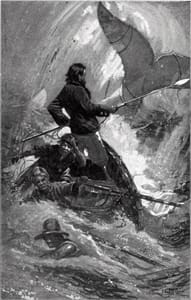By the time we reach the 118th chapter of Moby Dick, we are either emotionally exhausted or enthralled, sometimes both. At this point of the tale, we are closing in on the final chapter. I know how it ends, yet every time I discover something new.
Chapter 118 is titled “The Quadrant.” Ahab has given up on all semblance of what could be considered sanity, and his crew — under the influence of his madness — willingly chooses to follow wherever he takes them. In this short chapter, Ahab breaks all ties: with home, to science and to civilization. He destroys his quadrant. It was the quadrant and later the sextant that every offshore master of a sailing ship relied on for finding out where they were. Ahab makes it very clear that going home is no longer an option. By destroying his quadrant as “madness maddened,” Ahab chucks the science of navigation.
Melville writes, “It was hard upon high noon; and Ahab seated in the bows of his high-hoisted boat, was about taking his wonted daily observation of the sun to determine his latitude.” As far as we know, the whaling ship Pequod had no chronometer — it would have been too expensive a luxury for its parsimonious owners. The noon sight, of course, is not dependent on accurate time; it is based on the point where the sun has reached its maximum altitude. Mariners without accurate timepieces would wait on deck, marking the rising of the sun. When the sun reaches its highest altitude, hanging there for a few moments, the observation would be taken and calculated using the well-known formula of latitude = 90º – HO +/– declination.
Pequod at this point is at a dead reckoning position of 5º 10’ N by 157º W, close by Fanning Island. We can estimate the DR because we know Pequod departed New Bedford at Christmas, and based on the real-life sinking of the whaling ship Essex upon which the novel is based, would be around this area 10 months later. Melville writes that the sky is “lacquered; clouds there are none, the horizon floats … well that Ahab’s quadrant was furnished with colored glasses through which to take sight of that solar fire.”
Then in a moment of either clarity or insanity, Ahab, looking at his quadrant, mutters: “Curse thee, thou quadrant!” Ahab then throws the quadrant on the deck, exclaiming, “No longer will I guide my earthly way with thee … thus I trample on thee!”
Let us join this madman as he takes his last sun sight. We’ll say the date is Aug. 15. The DR is 5º 10’ N by 157º W. We’re taking a lower limb of the sun and the height of eye is 15 feet. The Hs is 81º 10’. We’ll use the 2018 Nautical Almanac.
Tip: For this exercise, we have both a north declination and north latitude. In this case, the declination is greater than the zenith distance (ZD); therefore, we subtract the ZD from the declination. The time we are using is 22:32 GMT. The declination at the time of the sight at 13º 50.1’ N.
A. What is Ho?
B. What is latitude?
Answers
A. Ho is 81° 22.0’
B. Latitude is 5º 12.1’

